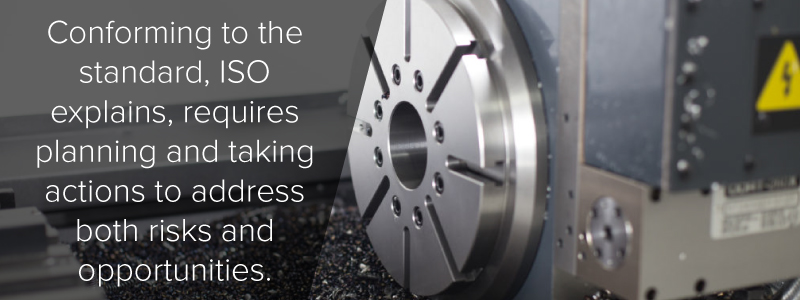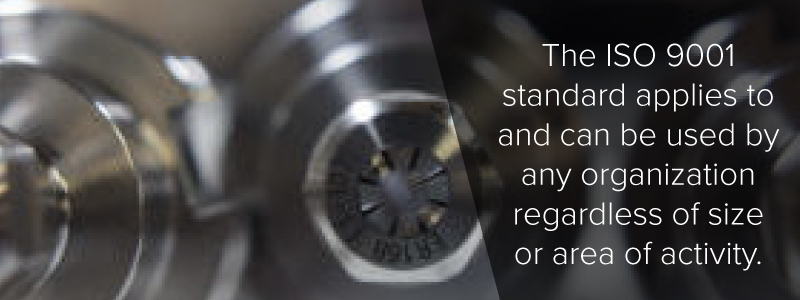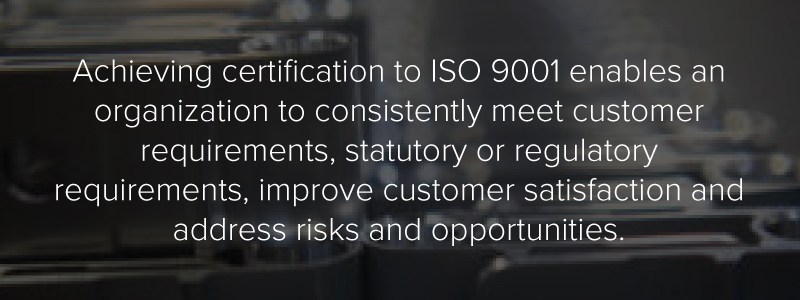ISO 9001 Guide
Customers want consistently high-quality products and services from the businesses they partner with. One vital way companies can make sure their customers know what to expect is by implementing a quality management system. How can you tell if a company has such a system in place? A sure sign is certification to the ISO 9001 standard.
At the Flinchbaugh Company, Inc., we build quality into every project we undertake. Quality assurance is a critical part of our approach to doing business, and ISO 9001 plays a central role in helping us maintain our high standards. As an ISO 9001-certified company, we understand the importance of reliably providing excellent products. You can learn more about ISO 9001 and its benefits below.

What Is ISO 9001?
ISO 9001 is the internationally-recognized standard for quality management systems put forth by the International Organization for Standardization (ISO). It is a voluntary standard adopted by businesses seeking to improve their operations.
The standard establishes criteria for quality management systems, or QMS. These are sets of procedures, processes and policies designed to ensure that a company meets the requirements and needs of its stakeholders — namely, its customers. A QMS helps a company improve its performance, consistently provide high-quality products or services, improve customer satisfaction and continually improve its operations.
The current version of ISO 9001 is ISO 9001:2015. This update replaced the 2008 version of the standard. Although the 2015 version is the most up-to-date, ISO 9001:2008 certifications will remain valid until September 2018. ISO 9001 is a part of the ISO 9000 standard family, which addresses various aspects of quality management. ISO 9001 is the only standard within the family that a business can be certified to. Technically, you cannot be ISO 9000-certified.

More than one million organizations across 170 countries are certified to ISO 9001.
What Does ISO 9001 Contain?
Seven quality management principles form the basis of ISO 9001:
- Customer focus: The primary goal of a QMS should be customer satisfaction.
- Leadership: Leadership at all levels should have a commonly understood purpose and direction.
- Engagement of people: Engaging people at all levels of an organization is crucial to its success.
- Process approach: Approach activities as part of interrelated processes that work together to form a coherent system.
- Improvement: Organizations should continuously focus on improvement. This enables it to maintain performance, respond to changes and create new opportunities.
- Evidence-based decision making: Analysis and evaluation of data and information should drive decisions.
- Relationship management: Organizations should manage their relationships with all interested parties, such as suppliers, to optimize their impact on performance.
Using a process approach for developing, implementing and improving the quality management system is an integral part of ISO 9001. Implementing this strategy involves defining and managing the business’ processes and how they interact with each other. This results in the effective management of the system as a whole. ISO describes the elements of a process as sources of inputs, activities, outputs and receivers of outputs.
Organizations can manage these processes and the overall system, ISO says, by using the Plan-Do-Check-Act (PDCA) cycle. The cycle works as follows:
- Plan: Establish the goals of a system and the resources needed to achieve, identify and address risks and opportunities
- Do: Carry out the established plan
- Check: Monitor and measure processes and their results as compared to objectives and report findings
- Act: Take steps to improve performance, if needed

Another important aspect of ISO 9001 is risk-based thinking. Conforming to the standard, ISO explains, requires planning and taking actions to address both risks and opportunities. This creates a basis for improving the QMS. Businesses should take action to prevent potential nonconformities, evaluate nonconformities if they do occur and take steps to prevent them from occuring again.
Starting with the 2015 edition, ISO 9001 uses Annex SL — a common structure that ISO now uses across all of its standards. It provides a shared organization, text, terms and definitions and is designed to allow for enhanced interoperability between standards and make implementation of the standards easier. Annex SL divides the ISO 9001 standard into 10 sections:
- Scope
- Normative references
- Terms and definitions
- The context of the organization
- Leadership
- Planning
- Support
- Operation
- Performance evaluation
- Improvement
Who Uses ISO Certifications?

The ISO 9001 standard applies to and can be used by any organization regardless of size or area of activity. While ISO offers a range of industry-specific standards based on ISO 9001, ISO 9001 itself applies to entities in any field. In fact, some of the main changes in the latest revision aimed to make it relevant to more types of organizations.
To enable a wide range of business to adopt ISO 9001, the standard avoids being prescriptive. Instead, participating organizations can define their own goals while using the standard as a guide. While organizations do need to meet certain requirements to achieve certifications, ISO aims to take a more flexible approach.
As mentioned earlier, more than one million organizations around the world use this international standard. The Flinchbaugh Company, Inc. is one of these organizations. Our certified QMS guides the inspection processes we use for all of the parts we make. We have advanced in-house inspection equipment, a highly skilled workforce and a commitment to quality that enables us to provide consistently superior products to our customers.
Benefits of ISO 9001
ISO 9001 compliance and certification offers numerous benefits to a company’s customers and to the organization itself. The advantages a QMS provides can impact nearly every part of a business’ operations:
1. Benefits for Customers
When customers partner with an ISO 9001-certified organization, they are more likely to receive products or services that are of a consistently high quality. The presence of an effective QMS dramatically increases the likelihood that the company will provide products that are free of defects as well as on-time service and delivery. This results in fewer returned products and time lost due to missed deadlines or defective goods.
When working with a company for the first time, customers also enjoy increased certainty if that business has implemented a certified QMS. They know that they have expressed a commitment to quality and that a qualified third party has verified their processes for honoring that commitment. This often makes the selection process much more manageable for customers if one business has an ISO 9001 certification and one does not.
2. Benefits for the Certified Organization
Increasing the confidence of potential customers in your capabilities is, of course, also beneficial for the ISO 9001-certified organization. Having this certification means you will likely win more contracts and get more business. In fact, some companies even require that all the organizations they work with have ISO 9001 certification. In these situations, it becomes more than an advantage. It’s a necessity.
Implementing a QMS also makes an organization’s internal processes more efficient and ensures that all employees have clear responsibilities. It also reduces business costs, improving your bottom line and allowing you to invest more back into your operations.
ISO 9001 compliance also has benefits for the employees of the certified organization. Research has found that ISO certification can lead to higher wages, increased employment and a reduced number of safety incidents.
The ISO 9001 systems also support continual improvement, so the benefits of implementation should increase over time.
What Are the Impacts of ISO 9001?
So what are the overall impacts of implementing ISO 9001? Using a QMS is a strategic business decision that has benefits for an organization and its customers. The system is designed to provide overall performance benefits and form a foundation for development initiatives.

Achieving certification to ISO 9001 enables an organization to consistently meet customer requirements as well as any statutory or regulatory requirements, improve customer satisfaction and address risks and opportunities as well as demonstrate compliance with all of the QMS requirements.
ISO 9001 does not require quality management systems across different organizations to be identical, have clause structure within your documentation that are identical to those of ISO or use the terminology with your organization that ISO uses.
How to Get ISO 9001-Certified
To achieve ISO 9001 certification, an organization needs to pass two external audits. Although timelines will vary, most organizations can achieve initial certification within six months.
Before you set up an audit, you must ensure that you have a thorough understanding of ISO 9001 and how it relates to your organization. You’ll start by defining your objectives and why you want to gain certification. Then you can begin to define your quality management system and determine how you will incorporate it into your operations.
To become certified, you will need the required policies and procedures in place. You will also need documentation of your QMS. This documentation includes:
- The structure of your organization
- What information will be recorded and who will record it
- The responsibilities of all employees
- Communication throughout the company
- Required actions
- A plan for maintaining continuity even when staff changes occur
Employees should receive training in proper documentation as necessary. You’ll also need a plan for taking corrective and preventative actions. You will have some autonomy in how you define these systems, processes, policies and procedures, but use ISO 9001 to guide you as you go. It is advisable that you conduct a round of internal audits before applying for an external one. You can choose to work with QMS professionals who will help you through the process of setting one up or do most of the work yourself. Many companies end up using a combination of these two approaches.
Once you’re ready for an external audit, you will work with a certified organization who will send an auditor to your location. The first visit from this auditor is designed to ensure that you are ready for a full audit. During this visit, the auditor will check that your QMS conforms to ISO 9001 standards, verify its implementation, review the certification’s scope and ensure legislative compliance. At the end of the assessment, they will provide you with a report identifying any non-compliance or improvement opportunities. If you need to make any changes, you’ll do so before the next stage: the full audit.
During the full audit, the assessor will audit all relevant processes and activities, document their findings and provide a report on any non-compliance. If they find any non-compliance, you have six months to correct it. If you do not correct within six months, you must undergo another full audit. If they do not find any non-compliance, you will become certified to ISO 9001.
Once you achieve certification, you will undergo regular surveillance audits and an eventual recertification audit to ensure that your system is still in compliance and to maintain your certification.
If you already certified to ISO 9001:2008 but wish to transition to the 2015 version, the process will likely be less involved. You will have to make some changes, but they won’t be as extensive as if you had not previously had an ISO 9001 certification. A company that is certified to the 2008 version can move to the 2015 version during your regular re-certification audit, during a surveillance visit or during a specially scheduled visit.
Our Quality Assurance Procedures
The Flinchbaugh Company, Inc. is fully certified to ISO 9001:2015. We’re also fully compliant with all MIL-I-45208A standards, which is the specification used by the military to establish requirements for all of its contractors’ inspection systems.
We build quality assurance into every step of our projects. Every time we receive a customer drawing, we complete a contract review checklist. At the start of each manufacturing setup, we conduct first-piece inspections. After receiving all job materials, we perform a receiving inspection. Finally, before we ship out a completed order, our quality assurance team conducts a final inspection.
We use advanced in-house inspection equipment and numerous manual gauges during our inspection process. We check every part we make for our customers so they know that when they work with us, they can depend on receiving consistently high-quality products that meet their specifications.
Why Work With an ISO-Certified Machine Shop?
When choosing a machine shop to partner with, look for one that is ISO 9001-certified. When you see that a business has this certification, you know they are committed to quality and that you can trust them to provide products that meet your requirements. In fact, non-compliance with ISO 9001 can be a warning sign that a company is not an appropriate partner for your machine part needs. A machine shop should be certified to inspect the parts they manufacture.
After all, when it comes to your machine parts, you don’t want to risk a defective product or late delivery. This can cause substantial financial loss, excessive lost time and increased safety hazards.
At the Flinchbaugh Company, Inc., we understand how vital it is to have machine shop parts that meet your needs the first time around. That’s why we prioritize quality assurance and maintain certification to ISO 9001:2015. Our commitment to quality runs deep. We’ve been ISO 9001-certified since 1998.
Additionally, we use the most cutting-edge machinery to produce our custom parts. We have capabilities and equipment that other machine shops just can’t match. For CNC machining as well as painting, grinding, and more — that meets all of your custom precision machining needs — partner with the Flinchbaugh Company, Inc. To learn more about our capabilities and how we can help your company meet its goals, contact us today.